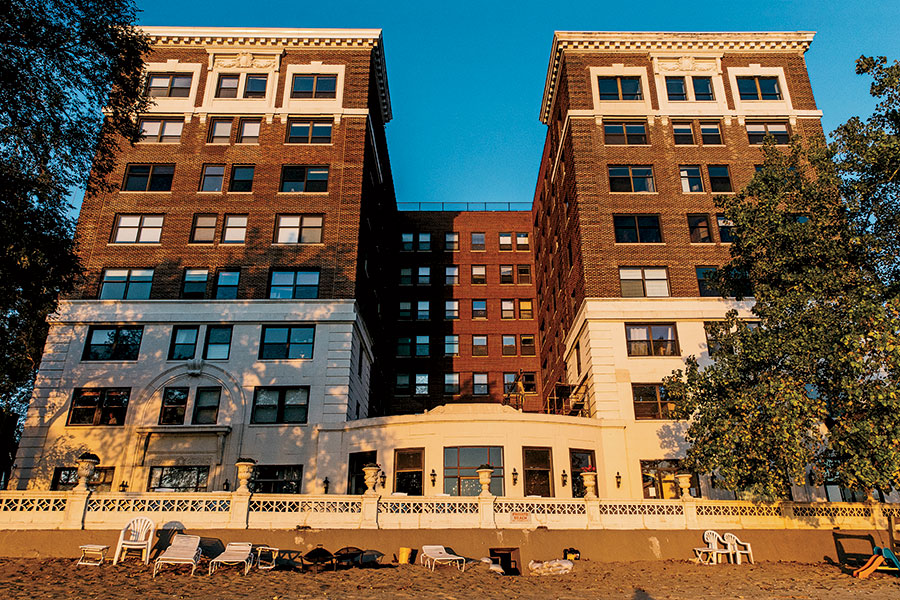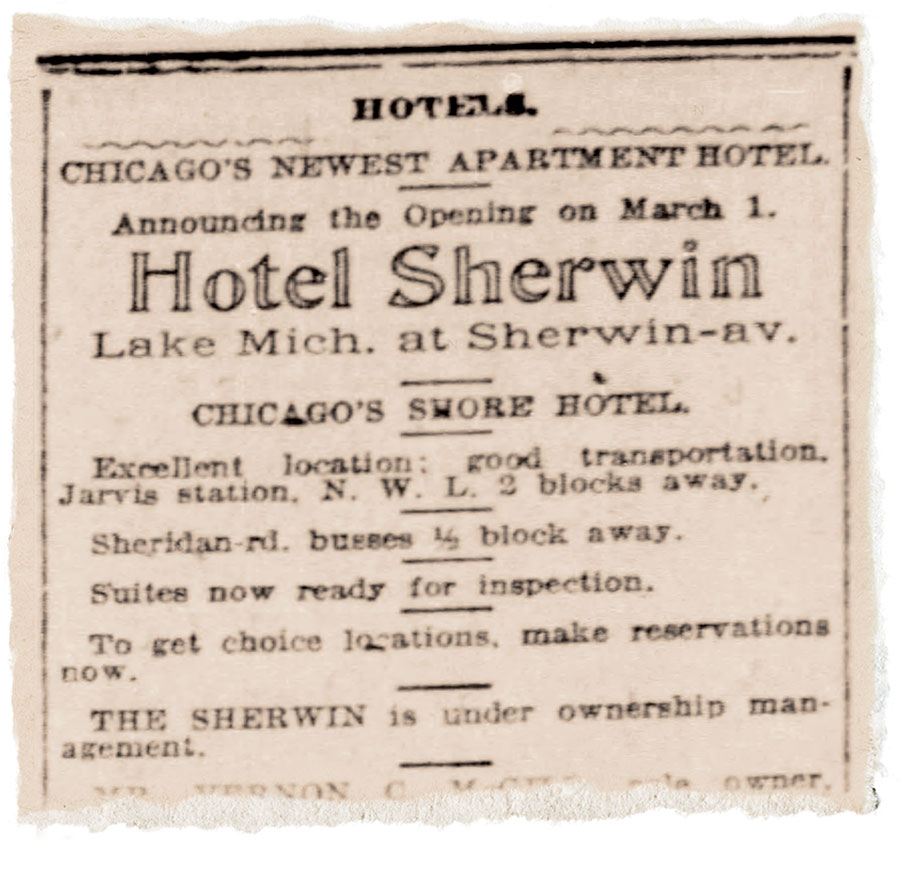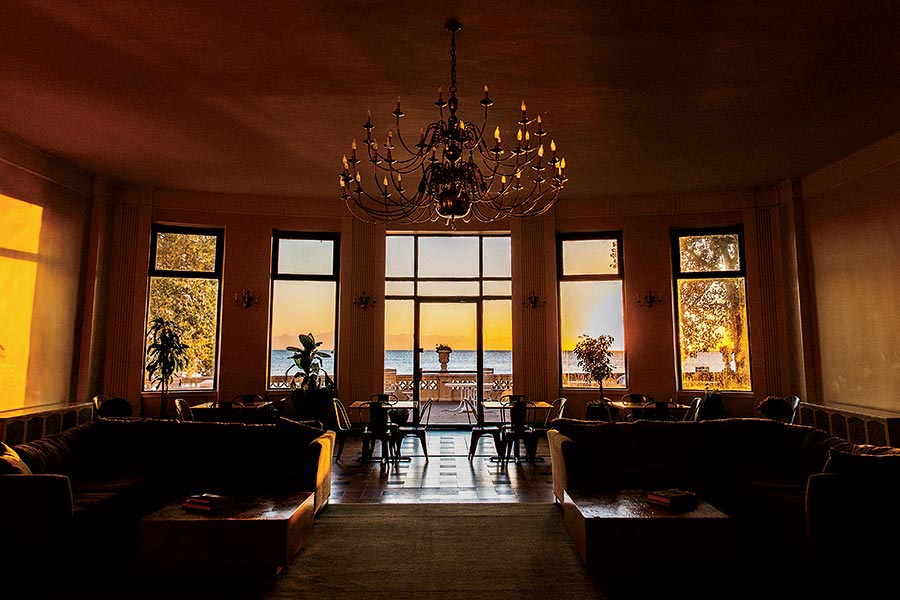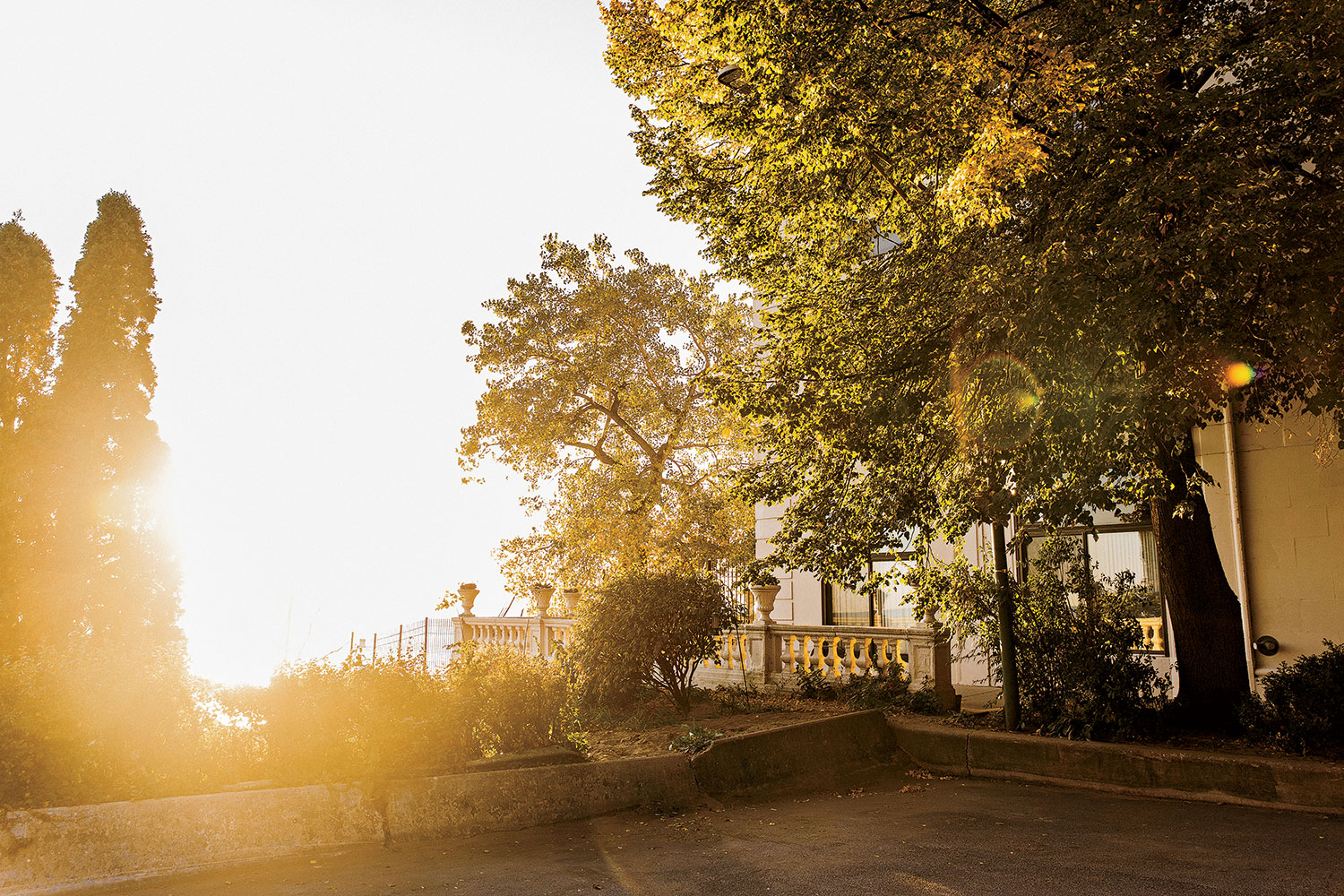One of my least favorite pieces of writing advice is “Make the setting into a character.” I admire the vivid rendering of time and place as much as the next bookworm, but the conflation of a story’s location with the people who populate it has always struck me as lazy and inaccurate. Character is character and setting is setting. A protagonist has a personality and a will that give the story momentum. Setting, the authentic depiction of an era and a locale, is crucial, too, but should serve the function of stage, not actor.
Or so I thought before I met — yes, met — the 96-year-old, eight-story Italianate edifice holding court as regally as a royal in exile at 1205 West Sherwin Avenue. The lakefront building, imposing and unmistakably the stately eccentric of her windswept block in Rogers Park, made me reconsider my bias.
Sherwin on the Lake, as the building is known, struck me as a poetic appellation, a little bit Stratford-upon-Avon in its iconic descriptiveness: proper name plus geographic feature. On the luminous night more than a decade ago that I first made her acquaintance on a stroll through the neighborhood, her air of world-weary glamour wafted across the sidewalk like an elegant older lady’s assertive perfume. As when one meets a beautiful person, the Sherwin charmed with her harmonious whole, the kind of allure that makes one long to linger.
For years, in my perambulations across the city’s northern reaches, I’d been pulled repeatedly into the Sherwin’s orbit. Towering over the sparkling water, leaning almost, evoking the prow of a grand cruise ship, she surveys Lake Michigan — sunrise to moonrise, snow to rain — never wavering as she watches each grain of sand on her private beach, each swimmer in the waves, each boat that floats by. Exuding a hard-earned charisma that can only be called human, the Sherwin is the kind of place one walks past and thinks, If only this building could talk! But she never opened up, never revealed herself to me. Until, until.
Late summer 2020. One pandemically lonely day when I was feeling sadder than average about not being able to see the people I loved, to say nothing of encountering strangers, a friend sent me a 34-page document titled Property History Quest Report: The Story of the Home at 1205 West Sherwin Avenue. It was, according to the title page, published in March by the Rogers Park/West Ridge Historical Society and “conducted for Brian Allemana and Amy McKeever,” presumably residents of the building. The friend explained that the historical society was giving buildings in my neighborhood, among them the Sherwin, a chance to speak, by way of an endeavor known as the Property History Quest. For $125, requesters can have volunteer researchers comb through every imaginable document related to a residence of their choosing: the site’s original title and deed, the first construction permits, decades’ worth of classified ads seeking buyers and tenants, newspaper items about noteworthy residents, and other ephemera. Several months later, those volunteers will produce, in essence, the building’s life story. And so I began to read hungrily about Sherwin on the Lake.

The tract of land that the building would come to dominate was part of an 1890 subdivision called Birchwood Beach, touted as a blend of pastoral living and convenient access to downtown by way of either the train or the recently paved Sheridan Road. After World War I, as demand for housing rose, affluent urbanites began to favor residential hotels, dwellings with onsite shopping and dining options, as well as an existence free, as American Builder magazine put it, “from household cares and servant worries.”
If the Sherwin can be said to have a father, he’d be Walter W. Ahlschlager, a Chicago architect prominent in his day for his residential hotels and newfangled movie palaces. (His handiwork includes the Logan Theatre in Logan Square, the Davis Theater in Lincoln Square, the InterContinental Hotel on the Magnificent Mile, and the Pierre, a condominium building in Lincoln Park.) In collaboration with the developer Vernon C. McGill, Ahlschlager conceived of the Hotel Sherwin as 119 apartments of one, two, or three bedrooms. The building would boast an art deco lobby, boat storage, and a veranda that ran for half a block overlooking the beach. The architect chose an Italian Renaissance style for the urban resort’s exterior —“the architecture of optimism during the Industrial Revolution,” as the Property History Quest report points out — and lavished her with the finest adornments: a public dining room in the manner of a sunken garden; the Triton Room, a card-playing area for gentlemen; and the Orangerie, a solarium and lounge for ladies. Prestressed concrete was chosen as the building material, which allowed the hotel to be promoted as fireproof, a seductive selling point with the Great Chicago Fire a not terribly distant memory.
Completed in 1924 and well received by the public and architecture critics alike, the ingénue enjoyed a brief star turn when the National Magazine declared that no other hotel on Lake Michigan could claim such a level of luxury. Nowhere else could a man “change into his bathing suit in his apartment, get to the main floor and be on the beach in less time than it takes for his bathtub to fill.” A work of art, they called her, “a veritable fairyland.”
Although the new hotel — which had run several hundreds of thousands of dollars over the original $1.7 million budget — filled quickly, her popularity proved fleeting, and in 1925, McGill sold the property to the Henry J. Stoops Hotel Company for $1.3 million, a considerable loss. From that moment on, according to the report, “rental rates dropped, based on classified ads from 1925 to 1979, never returning to the original levels.”

The chronicles contained in the bricks of the Sherwin detail not merely her own fortunes and misfortunes but also the rises and falls, the gentrification and decline, and the ethnic and economic shifts of her neighborhood and city and the country as a whole. In early 1929, the Edgewater Athletic Club, whose prestigious members were often trumpeted in the sports and society pages, made its home in the Hotel Sherwin. Its presence reveals both the widespread mania for clubs and sporting organizations in America in the 1910s and ’20s and the racism and anti-Semitism ingrained in daily life. Even though the architect of the hotel was himself of German Jewish descent, numerous early ads for the club it housed explicitly stated “Gentiles Only.”
Now, as anyone familiar with U.S. history will surmise, being opulent and overbudget on the eve of the Great Depression was less than auspicious, and yet the hotel rode out the economic blows of the ensuing years with a certain aplomb. As I delved deeper into the Property History Quest report, I felt I was exploring a veritable shadow box of stories, and through those stories, a curious image of the Sherwin emerged: that of a languorous hostess with an unperturbed attitude toward the vicissitudes of time. She seemed to be inviting me to pull up a chaise next to hers, dig my bare feet into the sand, and let her amuse me with tales of the people she’s known, the ones who’ve come and gone over the years, the geniuses and the weirdos and the everyday Joes and Janes whose joys and pain form the ever-thickening bedrock of continuously inhabited urban spots.
The Sherwin will tell you about the time in February 1934 when occupants had to flee the building amid a conflagration that caused $6,000 in damage. “A search of the basement … revealed a cache of oil-soaked rags in a storeroom, clear evidence of arson,” leading the authorities to pin the deed on an employee who had been fired the day before and made threats against the hotel.
But the Sherwin will also recount tales of a community with buoyant spirits in spite of the bleakness of the Depression. In July 1931, for instance, the Chicago Daily Tribune reported on the hotel’s resident simian. The ringtail monkey, named Snookie, was the pet of one Billie Forgey and was known for his “decided likes and dislikes.” Forgey told the reporter that if the monkey disapproved of a guest, he was “just as apt as not to break a phonograph record over his head,” which was rough on the guest, but also “bad on the record supply.”
Five years later, in June, that traditional month of weddings, the hotel made the papers again, on the occasion of an engagement party given for resident Rosemary White, fiancée of Chicago Bears end and assistant coach Luke Johnsos. The affair had been arranged by White’s employer, the Peoples Gas Light and Coke Company.
The Sherwin has stood stoically as her narratives hopscotched genres: comedy and tragedy, romance and farce, political exposé and even mystery. In 1944, Sherwin residents Mildred Roloff and Ann Gerber spotted a car on nearby Chase Avenue with a human hand and foot dangling limply from its trunk. The driver emerged, shoved the limbs back in, and sped off. Alarmed, the women reported the “murder car” to the police, who traced the license plate to Gus Knobloch’s auto repair shop on Birchwood Avenue. The mechanic there confessed that he knew the vehicle’s owner, George Newman, quite well. “As a matter of fact just today I was inside the car’s trunk trying to find the source of a rattle while George drove the car around the neighborhood,” he admitted. After “exchanging wry glances with his colleagues,” the report reads, an officer named Drury pronounced the case closed.
Like any savvy raconteur, the Sherwin knows the value of gossip. Take the “Toothpick-Wielding Detective in a Messy Non-Divorce,” the tale of James B. Mosher, a young “scientific farmer” who’d inherited a number of farms from his father and was sued for divorce in 1933 by his wife, “a comely brunette,” on the grounds of adultery. He immediately accused her of the same, which she denied. Mosher hired a private detective to keep watch on the couple’s unit in the Sherwin. Late one night, after one of the wife’s alleged lovers entered the apartment, the detective stuck a toothpick between the door and doorjamb. In court, he testified that when he returned at 7:30 the next morning, the toothpick remained, proving the gentleman caller had not left. Witnesses leveled mountains of evidence against both husband and wife until the judge declared that he was denying the divorce because both parties were equally guilty and deserved each other. Apparently they reconciled, because seven years later, the Tribune ran an engagement announcement for their daughter, Janet, a student at the Goodman Theater School, stating that her parents resided together at 1205 West Sherwin Avenue.
So, too, does the Sherwin know when to drop a big name, and she holds a special place in her heart for artists. June Leaf, known for her abstract allegorical paintings and kinetic sculptures, lived in the Sherwin at the time of her first gallery show at the University of Illinois’s Navy Pier campus in 1950. She moved to New York shortly thereafter and married the photographer Robert Frank. Perhaps a lesser artist but arguably more widely viewed, John M. Downs also called the Sherwin home; he was the courtroom sketch artist whose drawings appeared routinely in the Chicago Daily News and the Sun-Times, most notably his renderings of Richard Speck, John Wayne Gacy, and the Chicago Seven.

Conversant in science as well, the Sherwin will tell you about the pioneer in X-ray technology, Émil H. Grubbé, who resided there in the 1950s. According to a 1946 Chicago Medical Society bulletin, Grubbé was the first person to treat a patient with X-rays. Because the doctor conducted many of his experiments on himself, by 1958 he had undergone 91 surgeries to repair radiation damage to his face and hands. He died in 1960 at the age of 85, not long after his 93rd operation.
Like many Chicagoans, the Sherwin is both inured to corruption — in 1962, resident Thomas Selwyn, an assistant foreman at the City Bureau of Sewers, was investigated by the assistant state’s attorney for allegedly working part time for two companies holding sanitary district contracts — and fascinated by politics, or at least its attendant tumult. In 1968, resident Alan Feldman and his girlfriend, Cynthia Stannard, got arrested for planning to bomb two department stores in the Loop during a peace march commemorating the one-month anniversary of the confrontation between antiwar protesters and cops at the Democratic National Convention. The couple received the light sentence of five years’ probation.
Harboring hope for the future, the Sherwin loves to tell the story of how, in 1979, she was home to the baby boy who chose “the coldest, snowiest night to arrive.” Born to Rita and Andy Mueller, the baby showed up earlier than expected. The Muellers had called the building’s owner at the time, Victor Vaccaro, to see if they could use his truck to get to the hospital amid the now-legendary blizzard, but the engine wouldn’t start. While Andy was out on Sheridan Road, awaiting help, he was missing the action. Vaccaro and other neighbors helped deliver the baby — seven pounds and four ounces.

“Do not open door for strangers.” So commanded the sign at the entrance of Sherwin on the Lake on the evening I paid a visit, in the hope of getting inside. But then, as if compelled by the building herself, an exiting resident broke the rule for me, and suddenly I found myself standing in the sumptuous lobby — the ballroom-like allure as strong as ever, even though there were no more balls.
Moving through the lobby, I felt the spirit of the place palpably. Show yourself around, that spirit said, make yourself at home. Like a breeze passing through a window screen, I made my way to the majestic veranda: kayaks and cottonwood trees, café tables and chairs, blood-red geraniums in bas-relief pots. It felt like Miramare Castle in Trieste, onetime home of Archduke Ferdinand Maximilian, or some slightly gone-to-seed Eastern European resort gasping after the dying breaths of summer. Twilight fell with a gentle melancholy, a pastel sunset casting the sky in violet tints. Families frolicked, splashing in the water, and residents chatted up and down the terrace.
Advertisement
Sneaking back out, I noticed that an ad for a condo posted in the foyer had the same list of enticements promised by dozens of other such fliers over the past nine decades. This one advertised the usual blend of modern conveniences and luxury touches that one sees in virtually any real estate listing, but the Sherwin, I knew, could deliver something else: a little extravagance, a soupçon of excess, which is to say glamour.
Glamour, of course, is glamorous because it can perish. “Glamour” always has “faded” waiting to be appended like a prefix. A usually illusory romantic attractiveness, glamour works as an enchantment, a fascination, a bewitching. Etymologically, “glamour” comes from the Scottish phrase “to cast the glamor,” where glamor is the Scots word for a spell. The Sherwin’s had been cast on me.
Mystically, after my clandestine visit, as I was absent-mindedly perusing a Google map of Rogers Park, a label popped up over the digital footprint of the Sherwin for a business called Soulrise Astrology. I tapped on a link, and the website revealed the astrologer to be a certain Brian Allemana. Suddenly I remembered: His was one of the names on the Property History Quest report!

I reached out through the contact form on the Soulrise website. When we spoke, Allemana told me he’d lived in the Sherwin since 2011 and explained that a friend had requested the building history as a gift to him. He described his residency as “a magical experience of synchronicity,” characterized “by times I needed something I didn’t know that I needed and someone or something from the building provided it.” He recalled one instance when, feeling lonely and depressed during the period before he met his wife, he came upon a notice on the Sherwin’s bulletin board announcing “Sing-Along on Friday Night.” It turned out to be a lively gathering of residents bearing guitars and photocopied lyric sheets. “I just ended up going and connecting with a bunch of people,” he said. “Like, wow, I didn’t know I needed that.”
Of this Sherwinian serendipity, Allemana said, “This building seems to pull people in, and holds a space for them as they go through some crisis or deep transformation.”
When I suggested that the building’s May 1 birthday makes her a Taurus, Allemana was happy to accompany me down that path. He explained that Taurus has to do with durability and strength. “This feels like a Taurean building. Taurus doesn’t like change. Everything changes, but there’s a lot about the building that hasn’t changed. Little bits and pieces, even the tile on the ballroom floor, not all of it, but portions are still original.”
If the building were a person, Allemana said, “it would be a kind of older grandfatherly figure, someone very generous who has a lot of stories to tell, who knows how to make people smile. Who can be a little irascible. And kind of demanding, like ‘You have to earn my graces a little bit,’ but once you do, he’s very loyal.”
In the field known as humanistic geography, “space” is abstract, a mathematical or even scientific concept, physically measurable but without substantial personal or intimate meaning; “place” refers to how humans feel cognizant of and attracted to a particular chunk of space. In other words, a place is a space that resonates with meaning. Spaces becomes places when humans create social connections to and within them. Perhaps that’s what Allemana was referring to when he spoke to me of “something spontaneous that happens here that I don’t know if I could quite put into words.”

Over time I’ve come to think of the Sherwin less as a person than as a ghost — a presence that stays put as history moves forward. All old urban buildings, not just the Sherwin, are expressions of ideas of a bygone time, as well as places of incalculable lived lives and dreamt dreams. A building that we think of as historic is a site where history has happened, but equally a place where history hasn’t — unlike the cityscape around it, which has been built up and razed by the forces of progress. That is the paradox of the historic building.
One thing that won’t change for as long as the Sherwin stands is her unobstructed view of the lake, though one day the structure may succumb to the rising waters of the lake itself. But until then, the Sherwin will abide, unmoving but evoking the illusion of motion, the edifice remaining still as the waves crash around it.
And even when, heaven forfend, the Sherwin stands no longer, her stories will remain, like tracing paper, overlays upon overlays, palimpsests upon palimpsests — shades of the past never to be fully erased.




Comments are closed.